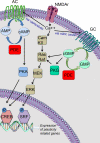Therapeutic utility of phosphodiesterase type I inhibitors in neurological conditions
- PMID: 21373359
- PMCID: PMC3044262
- DOI: 10.3389/fnins.2011.00021
Therapeutic utility of phosphodiesterase type I inhibitors in neurological conditions
Abstract
Neuronal plasticity is an essential property of the brain that is impaired in different neurological conditions. Phosphodiesterase type 1 (PDE1) inhibitors can enhance levels of the second messengers cAMP/cGMP leading to the expression of neuronal plasticity-related genes, neurotrophic factors, and neuroprotective molecules. These neuronal plasticity enhancement properties make PDE1 inhibitors good candidates as therapeutic agents in many neurological conditions. However, the lack of specificity of the drugs currently available poses a challenge to the systematic evaluation of the beneficial effect of these agents. The development of more specific drugs may pave the way for the use of PDE1 inhibitors as therapeutic agents in cases of neurodevelopmental conditions such as fetal alcohol spectrum disorders and in degenerative disorders such as Alzheimer's and Parkinson's.
Keywords: Alzheimer; Parkinson; cAMP; cGMP; drug development; fetal alcohol spectrum disorders; phosphodiesterase; vinpocetine.
Figures


Similar articles
-
The role of Phosphodiesterase-1 and its natural product inhibitors in Alzheimer's disease: A review.Front Pharmacol. 2022 Dec 21;13:1070677. doi: 10.3389/fphar.2022.1070677. eCollection 2022. Front Pharmacol. 2022. PMID: 36618909 Free PMC article. Review.
-
Phosphodiesterase 1: A Unique Drug Target for Degenerative Diseases and Cognitive Dysfunction.Adv Neurobiol. 2017;17:349-384. doi: 10.1007/978-3-319-58811-7_13. Adv Neurobiol. 2017. PMID: 28956339 Review.
-
Phosphodiesterase inhibitors say NO to Alzheimer's disease.Food Chem Toxicol. 2019 Dec;134:110822. doi: 10.1016/j.fct.2019.110822. Epub 2019 Sep 16. Food Chem Toxicol. 2019. PMID: 31536753 Review.
-
Vinpocetine amended prenatal valproic acid induced features of ASD possibly by altering markers of neuronal function, inflammation, and oxidative stress.Autism Res. 2021 Nov;14(11):2270-2286. doi: 10.1002/aur.2597. Epub 2021 Aug 20. Autism Res. 2021. PMID: 34415116
-
The flavonoid dioclein is a selective inhibitor of cyclic nucleotide phosphodiesterase type 1 (PDE1) and a cGMP-dependent protein kinase (PKG) vasorelaxant in human vascular tissue.Eur J Pharmacol. 2009 Oct 12;620(1-3):78-83. doi: 10.1016/j.ejphar.2009.08.008. Epub 2009 Aug 15. Eur J Pharmacol. 2009. PMID: 19686719
Cited by
-
A PDE1 inhibitor reduces adipogenesis in mice via regulation of lipolysis and adipogenic cell signaling.Exp Mol Med. 2019 Jan 11;51(1):1-15. doi: 10.1038/s12276-018-0198-7. Exp Mol Med. 2019. PMID: 30635550 Free PMC article.
-
Phosphodiesterase-4 Inhibitors for Non-COPD Respiratory Diseases.Front Pharmacol. 2021 Aug 5;12:518345. doi: 10.3389/fphar.2021.518345. eCollection 2021. Front Pharmacol. 2021. PMID: 34434103 Free PMC article. Review.
-
Drug Discovery and Development Targeting Dementia.Pharmaceuticals (Basel). 2023 Jan 19;16(2):151. doi: 10.3390/ph16020151. Pharmaceuticals (Basel). 2023. PMID: 37259302 Free PMC article. Review.
-
An update on vinpocetine: New discoveries and clinical implications.Eur J Pharmacol. 2018 Jan 15;819:30-34. doi: 10.1016/j.ejphar.2017.11.041. Epub 2017 Nov 26. Eur J Pharmacol. 2018. PMID: 29183836 Free PMC article. Review.
-
Phosphodiesterase Inhibition and Regulation of Dopaminergic Frontal and Striatal Functioning: Clinical Implications.Int J Neuropsychopharmacol. 2016 Apr 2;19(10):pyw030. doi: 10.1093/ijnp/pyw030. Int J Neuropsychopharmacol. 2016. PMID: 27037577 Free PMC article.
References
-
- Atkins C. M., Selcher J. C., Petraitis J. J., Trzaskos J. M., Sweatt J. D. (1998). The MAPK cascade is required for mammalian associative learning. Nat. Neurosci. 1, 602–609 - PubMed
-
- Bagetta V., Ghiglieri V., Sgobio C., Calabresi P., Picconi B. (2010). Synaptic dysfunction in Parkinson's disease. Biochem. Soc. Trans. 38, 493–497 - PubMed
-
- Barco A., Alaarcon J. M., Kandel E. (2002). Expression of constitutively active CREB protein facilitates the late phase of long-term potentiation by enhancing synaptic capture. Cell 35, 345–353 - PubMed
-
- Beavo J. A. (1995). Cyclic nucleotide phosphodiesterases: functional implications of multiple isoforms. Physiol. Rev. 75, 725–748 - PubMed
-
- Bereczki D., Fekete I. (2009). Vinpocetine for acute ischaemic stroke. Cochrane Database Syst. Rev. 23, CD000480 - PubMed
LinkOut - more resources
Full Text Sources
Other Literature Sources

